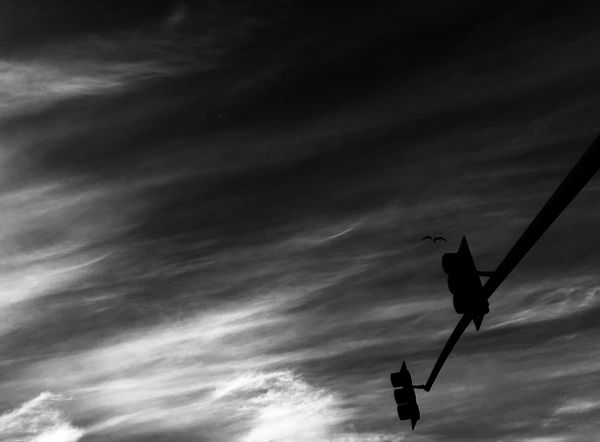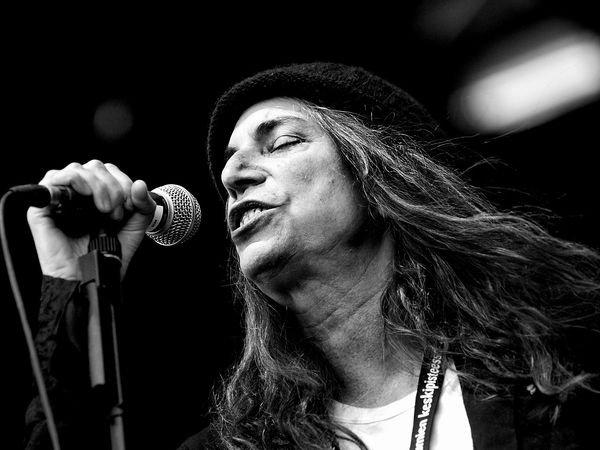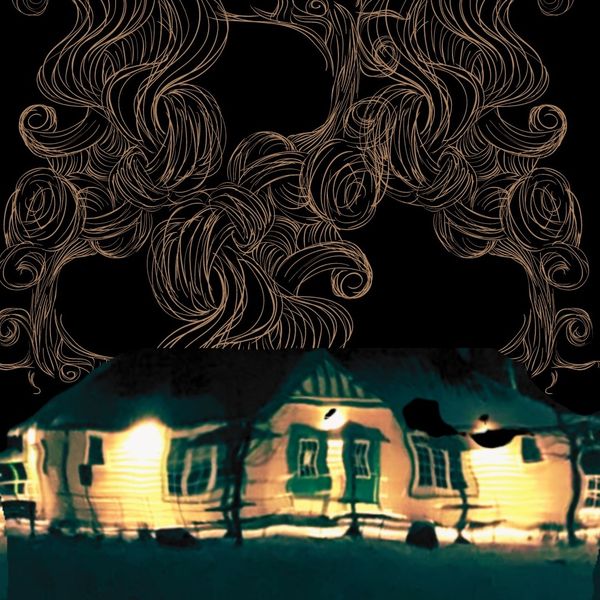Words and photos by Guillermo Manning
Few notice except those who have been
waiting through the long, glaring day.
—Joyce Carol Oates
Night-photography: a test for the eye. No flashes, no extra lights, my teacher said. Take what the street offers, follow your light-meters, watch your focus, get close to your subjects, look for the night within them. He wanted us to be invasive, voyeuristic; or at least the pictures had to reflect an attempt at getting close.
I went out late at night. During those days, I lived a block away from Telegraph Avenue. I used to walk down Telegraph towards Downtown Oakland, or the other way towards Berkeley. I decided to go to Berkeley. The first picture I took was a cross at the entrance of a church, lit up in the glow of a red neon light. This is where I'll end, I thought. I'll take another picture when I come full circle.
I stopped outside closed stores; I waited in corners for people to walk underneath pale lights. I went into a 24-hour laundromat where a couple was waiting for their clothes to dry and asked two girls coming out of a French restaurant, “Le Bateau Ivre,” if they could stop for a moment and look at the camera. They said no. As I approached the UC Berkeley campus, I worried that the pictures wouldn't be any good. I thought I would find students walking around, willing to be photographed, but the place was empty.
I reached Sather Tower, which had been visible throughout my walk. I stopped for a moment and sat on a bench. Every time I saw the tower, I remembered that a girl I liked, with long brown hair, had told me she'd kissed her boyfriend for the first time underneath it. She had given me an image: the tower standing as a witness while he approached her, touched her mouth, and started a life with her. I took a picture of the tower—of that moment. I would have wanted to be him. I would keep trying. Do you know Hart Crane's poem? I asked her when she told me. I don't, she said. "The bells… the bells break down their tower…" I tried to remember the rest of the stanza but jumped to the next important line: “And so it was I entered the broken world / To trace the visionary company of love…"
I turned left on Dwight Way and walked to People's Park; it was mostly dark, but at the center, a light pole produced a petrified white light that revealed tents and clothes and bottles on the ground. I took out the tripod and looked for an angle that would bring forth the light and the objects around it. I was about to take the picture when a man approached me, stepping into the light, and asked me what I was doing. I explained that it was a school assignment. You have to pay if you want to take a picture of us, he said. I repeated that I just wanted to photograph the pole. That light is ours, you have to pay. I took out my wallet. I only have 10. That's enough, he said and took the money. You can take my picture, he said, you just have to ask, but I guess you never ask, do you? You just need to say "can I do this, do you mind if I do that," but you don't do it—take my picture and maybe you'll remember. There, done, I said. Have a good night.
On College Avenue, walking back to Oakland. It was one in the morning. I could hear music coming from the dorms and houses where students lived. I remember thinking: this feels like a short story. The night before I had met Joyce Carol Oates. I was thinking about her stories. I knew she lived in Berkeley, in a house that had once belonged to Czeslaw Milosz. That semester she was teaching creative writing. Since I wasn't her student, I had gone to a reading she'd given at City Lights to try to talk to her. She was wearing a big dark hat; a man who wanted a picture with her had pointed out the hat didn’t help. She didn’t reply. When I finally approached her I asked her to dedicate a collection of stories to the girl, she doesn't know your work, I said, but I'm giving her this collection as a gift. Is she your girlfriend? she asked me. No, I replied. She smiled. The first story in the book is about a man who falls in love with a woman as she slowly walks across a bridge—"I will marry her. That one," he thinks, but that never happens. Oates's characters always look for love in the wrong places—they can never master their impulses—they are always doomed. (“Why do seemingly repellent states of mind possess, for some, an abiding attraction?” Oates writes in an essay.) What should we say to this girl? said Ms. Oates. "With kind regards," she smiled and signed it. It's always hard, isn't it? she said, handing me the book. Yes, I said. Well, let's hope she likes it, she replied. Good luck.
That's how I felt: like a character looking for love in the wrong place, a character exploring the night within him. I wanted to find an image that matched my state of mind. Instead, I imagined tiny plots unfolding behind the windows: a student watching Netflix while his roommate makes love in the next room, a couple about to go to sleep without talking to each other. Someone reading, someone taking a shower, a late-night dinner. I imagined what my life would look like if someone took a picture from outside my window. What would they think of my bed, the books on my night-stand, the empty cups of tea, my clothes meticulously organized, the large mirror next to the door? Capturing life is simple; what comes before is hard. But the world is a gift if one has the tools to turn wounds into images. I found the courage to stand next to a window lighted with blue-neon lights: inside, a girl was singing and playing guitar. I wish the camera had captured her voice…
Walking is the freest sport, says Peter Handke. I'd already used two film rolls; I had one left. I kept going straight. I stopped in front of the Berkeley Playhouse, the Rialto Cinema, and an Italian trattoria. I took pictures of trees. I wandered around Trader Joe's empty parking lot and photographed the last train arriving at the Rockridge station. At the end of College Avenue, there was McNally's, an Irish Pub that always closed late. I saved the last pictures and quickened my pace to get there.
A group of men was standing outside, drinking, laughing, smoking under green neon lights. Two women were seated at the bar talking. The bartender was looking at his phone. We close in ten minutes, he said. Also I need to see your ID. I asked him if I could take some pictures. One of your friends was here an hour ago. I guess we're very photogenic, he said to the women at the bar. Sure, he added, just no pictures of me. I walked around the pool table, captured the Oakland Raiders' flags hanging on the wall, the empty glasses in the small roundtables, the stools. Every time I took a picture, I looked at the women talking at the bar. At first, I'd thought they were older, but I realized they were close to my age. I caught fragments of their conversation. My place is ten minutes away… we've had a great time… the restaurant was great… One of them, with blonde hair, had her hand on the other's knee. I had two pictures left. I needed to save one for the cross at the end. I walked next to them and mumbled a few words: would you mind if…Yes, take our picture, said the blonde. She was drunk. They turned towards me and smiled. Perfect, I said. I want a copy, she said. I'll give you my email, send me a copy. I went outside. I was about to leave when the women came out. The blonde was holding the other's hand, pulling her towards Broadway. They were walking sloppily and fast. I crossed the street and stayed behind them.
I was thinking of Andre Kertész—how many people had he followed? How many times had his cameras invaded people's intimacy? There is a picture he took in 1915, in Budapest: a man and a woman, elegantly dressed, are about to kiss. He has both arms around her, one hand on her left shoulder, the other close to her neck; she is holding him too, her arms around his waist—but something is off. The woman is tilting her head back; her lips are sealed. I was thinking about this picture as the women reached the corner of Broadway and 51st Street and stopped for the light to change. The blonde turned and tried to kiss the other. I took the last picture from the other side of the street. But something changed; the other woman turned her head away. I think I'm going home, she said, I'm too drunk. I couldn't hear what the blonde replied, but she tried to convince her to stay. She tried to take the phone from her hand, but the other pushed her. I'll text you tomorrow, the other said. They argued for two minutes as the car arrived. "We're almost there, we had a great time…" the blonde kept saying. The car came; the girl jumped in. Fuck you, the blonde said and crossed the street.
Guillermo Manning is a writer of fiction, poetry and criticism, from Mexico City but currently based in the Lower East Side. He co-edits Laid Off NYC’s Letters section. Get to know him better: @gmanningr
*This short story is a response to Joyce Carol Oates’s latest collection, Night, Neon: Tales of Mystery and Suspense.



